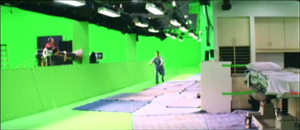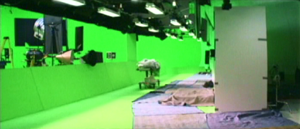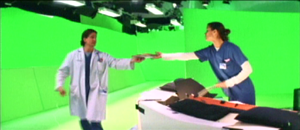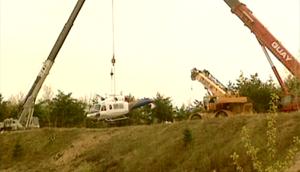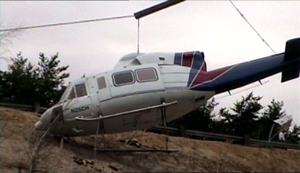
|
In the movie The Sum Of All Fears, there are many scenes that contain explosions with CG elements. One such notable scene is the major turning point in the film, where terrorists detonate a nuclear bomb in the city of Baltimore. Although the actual nuclear explosion is not shown to the viewer, the devastating effects of the shockwave as it rushes across the landscape, are. All the visual effects in the movie were created by a company called Rhythm & Hues. The blast sequence comprised three different shots, the hospital, the motorcade and the helicopter crash. |
The Shockwave Scene |
||||||
|
Making the Scene |
|||||||

Hospital Blast Impact |
To produce the hospital shot, Rhythm & Hues had to make a decision whether to do it as either a practical or visual effect. Doing a practical effect would have meant that the shot could only have one take as the set would be destroyed. Due to time contraints, they decided to use a visual effect. |
||||||
|
One of the main elements of this scene are the people and how they react when suddenly hit by the shockwave blast. Because of the number of actors involved in the scene, Rhythm & Hues decided that using green screens would be the best approach for filming. Each actor performed their specific piece in a specially constructed green screen stage that replicated the original hospital set. There were 12 different people in the scene so there were 12 different green screen shots. |
|||||||
|
|||||||
|
Each person was attached to a cable which, when activated pulled the person at a high velocity as if they had been blown by the blast. if the bottom right image above is viewed carefully, the wire attachment can be seen on the mans back. All props were were also filmed on the green screen stage. Instead of a wire, the props were blown away by air cannons. |
|||||||
|
Pulled By A Wire |
Blown Away By Air Cannons |
||||||
|
To create the effect for the windows being blown in by the blast, Houdini was used to create CG glass with a particle system. Overlayed over the top of the shattering glass were other CG elements comprising of dust and debris. |
|||||||
|
CG Glass Particles |
CG Dust and Debris |
||||||
|
There were between 50 and 60 different green screen and CG shots that all required compositing together to create the final sequence. |
|||||||
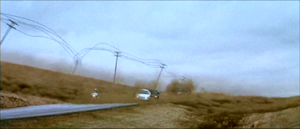
Motorcade Blast Impact |
In the motorcade shot, the vehicles are blown over by the initial shockwave. This shot is a mixture of live action and CG. This shot was created using a mixture of live action and CG. |
||||||
|
To give the impression that the blast wind lifts the vehicles up, they were fitted with a special hydraulic ram. The rams were used to lift the backs of the vehicles up about 3 feet and hold them there for a few seconds until they then toppled over and crashed. |
|||||||
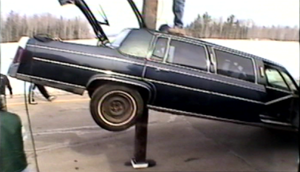
Hydraulic Ram |
Ram in Action |
||||||
|
Once the real vehicles crashes were filmed, they were then modelled in Houdini and the models were animated to match the exact movement of the real vehicles. These models would act as invisible obstacles for the shockwave dust. The shockwave dust was constructed from 3D volumetric shapes in Houdini. The dust shapes would travel along the ground but went around or over the vehicle models. Without the vehicle models, the dust appeared to travel through the real vehicles. |
Houdini Animation Sequence |
||||||

Helicopter Blast Impact |
The helicopter sequence used a mixture of real action, CG models and CG effects. At the start of the scene, a real helicopter is filmed flying. To give the appearance of the helicopter being hit by the shockwave, it was subjected to very violent turbulence. Due to the amount of turbulence the helicopter experienced, a CG model was used. |
||||||
|
The actual impact of the helicopter into the ground was created by building a full scale model of the helicopter. This model was suspended between two cranes on a cable. The model propelled into the ground where it detached itself from the cables and rolled down the hill. |
|||||||
|
|||||||
|
A CG element that had to be added to the helicopter as it rolled down the hill was the addition of the roto blades. The blades had to match the helicopter's orientation and position as it rolled. They also had to break up as they impacted the ground. |
|||||||

Rolling Down The Hill |
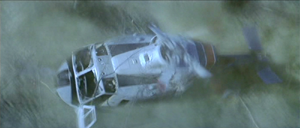
Added CG Blades |
||||||
|
All of the dust produced from the shockwave that is visible during the helicopter crash sequence is produced by CG in Houdini. It was created with 3D volumetric shapes and was used to create the final shot of the mushroom cloud.
|
Houdini Dust and Smoke |
||||||
|
|||||||
